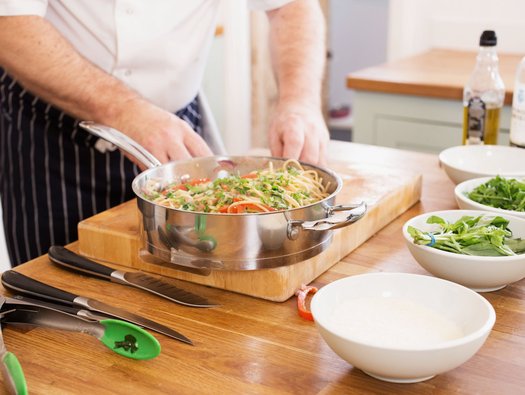Garlic and chilli whole wheat pasta

This is a quick and simple recipe. It’s perfect for those following a low protein diet but easy enough to adapt if you need more protein.

This is a quick and simple recipe. It’s perfect for those following a low protein diet but easy enough to adapt if you need more protein.
400g whole wheat spaghetti
50ml olive oil
6 garlic cloves
1-2 red chilli peppers
1 red onion
1 red pepper
1 small courgette
200ml white wine
90g baby spinach
20g parsley
20g basil
15-20g Italian hard cheese
Fill a large saucepan with water and bring to the boil. Add the spaghetti and cook until al dente, about 10-12 minutes.
Prepare and set aside the vegetables. Peel and thinly slice the garlic, chilli peppers and red onion. Deseed and slice the red pepper into strips and slice the courgette into thin strips.
Add the olive oil to a frying pan on a medium heat, add the garlic and chilli, stirring regularly for about 5 minutes or until the garlic is golden. Add the onion, red pepper and courgette. Cook gently until just soft.
Pour in the white wine and cook for a further 2-3 minutes.
Once cooked, drain the spaghetti and add to the vegetables. Add in the spinach and toss to coat well.
Season with pepper and sprinkle with chopped parsley and basil. Serve with the Italian hard cheese grated over the top.
The spaghetti is the main source of carbohydrate in this dish. The total carbohydrate value has been provided for those who are trained in insulin adjustment.
This recipe is low in phosphate however, if you add more cheese to the recipe or if you decide you’d like to add additional protein then please be aware that this will increase the phosphate content of the meal. If you have been prescribed a phosphate binder ensure you take them with this dish.
As this dish has very little protein, it is also low in potassium. Adding extra protein will also increase the potassium content so you may want to miss out the spinach, which is a high potassium vegetable.
This is a low protein dish, which is great if you have been advised to reduce your protein. If you have been advised to increase your protein, serve with fresh fish, tinned tuna or lean chicken. To keep it vegetarian, try adding meat alternative pieces.
Use a gluten-free spaghetti.
Check that the Italian hard cheese you choose is vegetarian.
Use a non-dairy vegan cheese.
To reduce the fat content of this dish, you could use less oil in the cooking and less cheese, or omit the cheese completely. Try to use whole wheat spaghetti in this recipe as it is higher in fibre than white spaghetti.
To keep the cost low, if you don’t have any white wine, purchase a mini bottle which usually has between 175-250ml. You could also use dried herbs instead of fresh. Add dried herbs when you add the garlic and chilli, using one teaspoon of each.
Allow to cool and store in an airtight container in the fridge for up to two days. Reheat thoroughly before serving.
If you are not vegetarian, an authentic Italian parmesan cheese will accompany this dish nicely.
By giving us your email address, you're giving us permission to send you the latest news from Kidney Care UK. Further information about how we protect and use your personal data is available in our Privacy policy. If you would like to change the way we communicate with you at any time please email [email protected]. You can unsubscribe at any time by using the link at the bottom of every email we send.